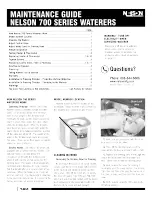
3-1-618 Page 13
Initially set the lubricator to deliver eight (8) to ten
(10) drops of oil per minute to each stuffing box. More
flow may be required for large plungers and/or high
speeds, pressures or pumped fluid temperatures.
Less flow may be needed for small plungers and/or
low speeds or pressures. Flow can be controlled by
backing off the jamb nut that locks each plunger body
in position on the lubricator and rotating the plunger
body. Rotate the plunger clockwise to increase flow
and counter clockwise to decrease flow. Lock the
jamb nuts down again after making an adjustment.
Increase the flow if the packing starts to heat up
FLUID END CORROSIVE ATTACK
– Some fluid
cylinders and components (especially valve decks
and seats) experience corrosive attack from
chemicals in the water being pumped. To avoid
damage to pump components, water containing
corrosive chemicals should be treated to neutralize
corrosive properties before it is pumped. To
determine if corrosive chemicals are present in
pumped water, a sample should be chemically
analyzed and/or one or more sacrificial anodes
should be placed in the suction fluid stream. If the
water analysis shows corrosive chemicals are
present, or on frequent inspection the anode is
observed to be eaten away, the fluid should be
treated. Anodes, mounted on threaded plugs, are
available from Gardner Denver Inc.
SERVICE INSTRUCTIONS - POWER END
ECCENTRIC
The drive shaft extension can be
located on either side of the pump by installing the
eccentric in the desired position.
To remove eccentric, remove end plates from both
sides. Main bearings are cylindrical and spherical
roller type and the cups remain in the end plates as
they are removed. The oil must be removed from the
power end before eccentric removal.
Support the shaft on a rope sling and remove
eccentric shaft and bearing cones from sheave side
of pump.
Connecting rods will slip over the cams as the
eccentric is removed.
Bearings are to be replaced if worn excessively or
damaged. A damaged bearing will be noisy. Do not
remove protective grease in new bearings; it will not
contaminate the crankcase oil.
CROSSHEAD AND PINS
- Crossheads can be
removed through the oil stop head openings.
Crossheads are equipped with straight pins, secured
on each end by setscrews and locknuts. The
setscrews and locknuts can be reached through the
hood opening located on the top of the frame.
It will be necessary to remove one (1) outside
crosshead to gain access to the center pin.
Remove the plunger coupling, loosen the gland nut,
remove the plunger and oil stop head. Next, slide the
crossheads through oil stop head bores in frame and
lift clear of the pump. Be careful to protect the lower
slide from damage in the frame by placing a wooden
block beneath the small end of the connecting rod.
When reassembling, be sure the seals are in place
on the oil stop heads.
NOTE: Oversize crossheads are available from
Gardner Denver Inc.
CONNECTING RODS
- Eccentric must be removed
before connecting rods can be removed. Rods have
solid bushings at the crosshead and the eccentric
end. Each can be pressed out and replaced if
necessary. It is best to shrink new bushings by
freezing before installing in rod, instead of pressing
in. Install crossheads, connecting rod and eccentric
in reverse order of above.
MAIN BEARINGS –
Main bearings are cylindrical
and spherical roller type. The spherical roller bearing
is on the drive side of the main shaft and the
cylindrical on the opposite end. No end clearance is
necessary, the cylindrical bearing can float axially to
some degree. Bearing cones are a shrink fit onto the
eccentric shaft and the cups are a light fit in the end
plates.
ECCENTRIC SHAFT ASSEMBLY PROCEDURE
Install key in the eccentric shaft and freeze the shaft
before assembling into the eccentric bore. Use the
dimensions shown in page 15, for correct positioning
of the shaft.
EXTENSION RODS
– Each extension rod and
crosshead assembly can be removed from the pump
by working through handhole plates located on the
sides of frame and also through the oil stop head
openings after oil stop head assemblies have been
removed. Be careful not to damage the highly
polished surface on which oil seals travel.
CAUTION
Extension rods are plated and should be
protected when the pump is repainted.
Paint on the extension rods will damage
oil stop head seals when the pump is in
operation.
















































